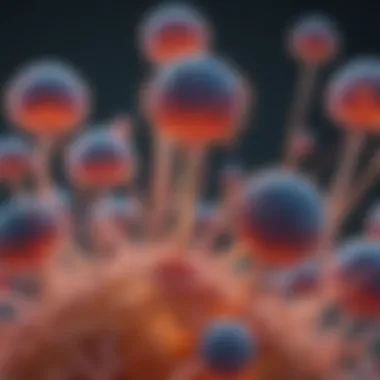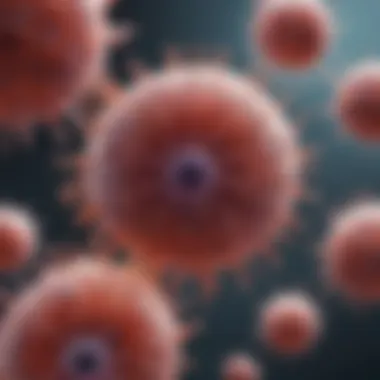Exploring Macrophage Cell Markers in Immunology


Intro
Macrophages, the robust soldiers of the immune system, play a pivotal role in maintaining homeostasis and defending the body against pathogens. These dynamic cells exhibit a remarkable diversity in phenotypes, driven primarily by their surface markers. Understanding macrophage cell markers is akin to unlocking the secrets behind cellular functionality, facilitating insights into both health and disease. In this examination of macrophage cell markers, we aim to peel back the layers, revealing the intricacies that come together to form the foundation of immunological response and cellular biology.
The journey ahead will highlight the critical significance of various macrophage markers while shedding light on their roles in physiological processes and pathological developments. With the backdrop of advancing research, we will underscore the implications these markers hold for innovative diagnostics and cutting-edge therapeutic approaches.
As we embark on this exploration, we will cater to the interests of a broad audience. From seasoned researchers and academic professionals to enthusiastic students keen on diving into the realms of immunology, there's something valuable for everyone in understanding why these cellular markers are not just prolific but essential in the modern scientific narrative.
Preamble to Macrophage Biology
Macrophages are far more than just another type of immune cell; they are pivotal players in the body’s defense mechanisms. Understanding macrophage biology is crucial for grasping their roles in health and disease. This section aims to deliver insight into their significance, shedding light on how they monitor bodily processes and react to threats. Every tissue harbors these cells, which can adapt to their environments in complex ways, making them central to immunological functions.
The adoption of new research techniques has unraveled many of their intricate behaviors, illuminating both the protective and sometimes detrimental roles they can play. It’s essential to grasp this multidimensional role if one is to appreciate the larger immune landscape.
Significance of Macrophages in the Immune System
Macrophages serve as the watchmen of the immune system. Their responsibilities extend from detecting pathogens to orchestrating immune responses. They exist at the intersection of innate and adaptive immunity, which is significant in how the body navigates various forms of threats.
- Pathogen Clearance: Upon encountering a pathogen, macrophages act quickly, engulfing and digesting invaders through a process known as phagocytosis. They don’t just act individually; they help coordinate the activity of other immune cells by releasing cytokines, guiding the body's response.
- Tissue Homeostasis: Beyond mere defense, they also play a role in maintaining homeostasis. They clear dead cells and debris from tissues, which helps in normal bodily functions like healing and regeneration.
- Adaptive Immunity: Macrophages further participate in adaptive immunity by presenting processed antigens to T-cells. This interaction is crucial for establishing long-term immunological memory and tailoring responses against specific threats.
Consequently, an appropriate understanding of macrophage function is not simply a biological interest; it has direct implications for therapies targeting inflammatory diseases, cancer, and other conditions.
Historical Perspectives on Macrophage Research
The journey of macrophage research is a fascinating tale reflecting broader paradigms in immunology.
- Early Observations: The concept of macrophages began in the late 19th century, with scientists like Elie Metchnikoff, who coined the term in relation to his observations on phagocytes in starfish larvae. This marked a pivotal moment, laying the groundwork for cellular immunology.
- Advancements in Technology: Fast forward to the late 20th century, the advent of flow cytometry and advanced imaging techniques enabled researchers to dissect the diverse roles and types of macrophages in unprecedented detail.
- Current Trends: Today, with the rise of single-cell sequencing and other high-throughput technologies, the field has expanded further. Researchers are now able to label and trace the dynamic behaviors of these cells in real-time, moving us from a static perspective to one that captures their intricate, ongoing actions.
The evolving understanding of macrophages underscores a broader truth in science—the more we learn, the more we realize how much there is still to discover. As we unravel the details of their biology, we edge closer to unlocking new therapeutic avenues that leverage the inherent power of these remarkable cells.
Defining Macrophage Cell Markers
Defining macrophage cell markers holds immense significance in understanding the complex role these immune cells carry out in the body. Macrophages are not just passive players in the immune system; they are dynamic cells that respond to various stimuli. Their markers are essential for distinguishing between different macrophage states, which could vary significantly depending on the surrounding tissue environment, such as infection or injury. This section lays the groundwork for understanding how macrophages can be identified, characterized, and utilized in both research and clinical settings.
Concept of Cell Markers
Cell markers refer to specific proteins or molecules expressed on the cell surface that help in identifying and classifying different cell types. In the context of macrophages, these markers are crucial because they provide insights into the functionality of these cells. For example, the expression of certain markers can indicate whether a macrophage is in a resting state or activated, which greatly influences its immune response. By exploring the concept of cell markers, researchers can gain a better understanding of macrophage heterogeneity and its implications in health and disease.
Commonly Recognized Surface Markers
CD14
CD14 is a notable marker that plays a vital role in the recognition of pathogens. It acts as a co-receptor for the detection of lipopolysaccharides, common components of bacterial cell walls. This interaction enables the macrophages to initiate an immune response, making CD14 crucial for activating signaling pathways leading to inflammation. CD14's high expression levels on monocytes and macrophages make it a popular choice for studies involving immune responses to infections. However, a drawback could be its variability across different macrophage populations, which might complicate results in diverse tissue environments.
CD68
CD68 is another widely recognized marker, known especially for its role in phagocytosis. Unlike CD14, CD68 is considered a pan-macrophage marker, as it is associated with both tissue-resident and circulating macrophages. Its presence signals a macrophage's capability to engulf pathogens and cellular debris. The broad utility of CD68 across various studies relating to autoimmunity and chronic inflammation makes it a beneficial marker. However, researchers will need to keep in mind that CD68 is expressed in other cell types too, which may introduce some confusion when interpreting results.
CD80
In the realm of T-cell activation, CD80 stands out. It is a costimulatory molecule expressed on activated macrophages, aiding in T-cell activation and promoting a more robust immune response. Its expression can signify an inflammatory state of macrophages, often encountered during infection or tissue damage. Utilizing CD80 as a cell marker in research settings aids in comprehending how macrophages influence T-cell behavior. One downside, however, is that CD80's expression can vary widely based on environmental signals, making it essential to consider the context when interpreting findings.
CD86
Like CD80, CD86 also contributes to T-cell activation and is indicative of an activated state of macrophages. It is generally upregulated upon activation, signaling the macrophages’ role in immune co-stimulation. This makes CD86 a useful marker in understanding the T-cell's interaction with macrophages during immune responses. The interconnected roles of CD80 and CD86 in immune modulation make them popular research targets, although researchers should remain vigilant about the possibility of overlapping expression profiles in varying cell types.
MHC Class
MHC Class II molecules are vital for antigen presentation to CD4+ T cells. Their expression on macrophages indicates that these cells are not merely collectors of pathogens but also active participants in shaping the adaptive immune response. MHC Class II serves as a crucial marker for identifying macrophages engaged in immune surveillance and response tasks. The trade-off is that while they provide essential insights, MHC Class II expression can be influenced by external factors such as cytokine availability, which may lead to inconsistent marker expression across different macrophage populations.
Understanding macrophage markers is crucial for researchers, as these markers illuminate the ever-changing nature of macrophage behavior, directly impacting therapeutic strategies and research conclusions.


Understanding macrophage markers is crucial for researchers, as these markers illuminate the ever-changing nature of macrophage behavior, directly impacting therapeutic strategies and research conclusions.
By carefully assessing these markers, investigators can draw meaningful conclusions about how macrophages function, their roles in different conditions, and potential therapeutic avenues to explore.
Classifications of Macrophage Markers
Understanding the classifications of macrophage markers is crucial for deciphering the multifaceted roles these cells play in our immune system. Macrophages are not just simple immune sentinels; they exhibit a remarkable degree of plasticity, adapting their functions in response to various stimuli. This adaptability is reflected in their surface markers, which can be categorized into distinct groups, helping researchers and clinicians alike in pinpointing their states and functions in both health and disease.
Recognizing the classifications of macrophage markers enhances our understanding of macrophage biology. It fosters insights into how these cells interact with other immune components and their environment. Further, distinguishing between different macrophage phenotypes can aid in targeting therapies that leverage these cells’ unique properties in various disease contexts.
M1 and M2 Phenotypes
M1 and M2 phenotypes represent two ends of the macrophage activation spectrum. M1 macrophages, often dubbed the "classically activated" type, are associated with pro-inflammatory responses. These cells are adept at producing cytokines, and reactive oxygen species, and can effectively present antigens. They play a pivotal role in fighting off pathogens and initiating the immune response.
Conversely, M2 macrophages, known as "alternatively activated" phenotypes, are crucial for tissue repair and resolution of inflammation. Unlike M1s, M2s produce anti-inflammatory cytokines and promote healing. The balance between M1 and M2 macrophages is critical; an overabundance of either can lead to disorders. For instance, excessive M1 activation is involved in chronic inflammatory conditions, while an excess of M2 can contribute to tumor growth and progression.
The dichotomy of M1 and M2 also hints at the complexity inherent in macrophage functions. Notably, a single macrophage may embody characteristics of both phenotypes under variable microenvironmental cues, a concept that's not only fascinating but fundamentally reshapes our understanding of immune regulation.
Markers Associated with Activation States
Markers associated with macrophage activation states offer a window into the functional dynamics of these cells. Different markers correlate closely with activation status, allowing researchers to identify the functional state of macrophages with precision.
- CD80 and CD86: These co-stimulatory molecules are prominent on M1 macrophages. Their expression is essential for T cell activation, linking macrophages to adaptive immunity.
- Arginase-1 (Arg1): This enzyme is typically expressed by M2 macrophages and plays a role in tissue repair by mitigating inflammation and promoting angiogenesis.
- CD206 (mannose receptor): A hallmark of M2 macrophages, its presence indicates a skewing towards a healing and anti-inflammatory phenotype, i.e., essential for orchestrating tissue repair post-injury.
"Understanding these markers and their expressions not only speeds up diagnostics but also illuminates pathways for innovative therapeutic strategies."
"Understanding these markers and their expressions not only speeds up diagnostics but also illuminates pathways for innovative therapeutic strategies."
Moreover, tracking the shifts in marker expression can reflect changes in the microenvironment. For example, under pathological conditions such as cancer or chronic inflammation, macrophages may rapidly alter their marker profile, indicating a shift from a homeostatic to a reactive state.
In summary, the meticulous classification of macrophage markers into M1 and M2 phenotypes, alongside the markers linked to their activation states, paves the way for significant advancements in both clinical and research settings. The comprehension of these classifications could lead to better-targeted immunotherapies and a deeper insight into macrophage biology, underscoring the relevance of tailored strategies in medicine.
Functional Implications of Macrophage Markers
Understanding the functional implications of macrophage markers is pivotal to grasping how these cells contribute to immune responses and tissue homeostasis. Macrophages, often dubbed the "watchdogs" of the immune system, possess a plethora of surface markers that define their functionality and activation state. The role of these markers transcends basic identification; they are fundamental in governing the fate of immune interactions and determining the outcome of various disease processes. Focusing on the implications of these markers enhances our understanding of their significant involvement in both health and disease.
Role in Immune Response
The immune system operates as a vigilant guardian against pathogens, and macrophages are at the forefront, armed with their distinct markers that signal readiness for action. Surface markers like CD14, CD68, and CD80 are crucial in modulating macrophage activation stages. For instance, CD14 serves as a receptor for lipopolysaccharide, a component of bacterial membranes, triggering downstream signaling that prompts macrophages to engulf and destroy invading pathogens.
Moreover, the dichotomy of M1 and M2 macrophages, characterized by their distinctive markers, showcases the complexity of immune responses. M1 macrophages, marked by CD80 and MHC Class II, are typically associated with pro-inflammatory responses, effectively mediating the innate immune response against infections. Conversely, M2 macrophages, identifiable through markers such as CD206, are key players in parasitic infections and are vital for tissue resolution and repair following inflammatory insults.
This functional versatility highlights why researchers invest considerable effort into studying these markers — understanding their expression can reveal crucial insights into immune dysfunctions seen in diseases like autoimmune disorders or chronic infections.
Influence on Tissue Repair and Regeneration
In the realm of tissue repair, macrophages play a surprisingly nuanced role. After tissue injury, activated macrophages orchestrate healing processes, a phenomenon richly painted by their expression of specific markers. M2 macrophages, for instance, are known for promoting tissue regeneration by releasing growth factors that facilitate cell proliferation and angiogenesis.
The dynamic nature of macrophage markers during the healing process can significantly influence outcomes. For example, high levels of CD206 can assist in the resolution of inflammation and the initiation of repair mechanisms. This highlights a critical point: the balance in macrophage activation and marker expression can sway the fate of tissues from effective regeneration to fibrosis or chronic inflammation.
"Macrophage markers not only define cellular identity but also orchestrate the spectrum of immune responses, profoundly influencing tissue repairing processes."
"Macrophage markers not only define cellular identity but also orchestrate the spectrum of immune responses, profoundly influencing tissue repairing processes."
Overall, through their diverse array of markers, macrophages can influence not just immune responses but also the healing process following injury, underscoring their significance in medicine. By studying these implications, researchers can explore potential therapeutic avenues targeting macrophage markers to modulate responses in diseases, paving the way for innovative treatments.
The depth of knowledge surrounding macrophage markers continues to expand, bringing to light the numerous ways these cells shape bodily responses. Their roles, far from being static, evolve depending on the context, revealing a complexity that continues to intrigue the scientific community.
Methodologies for Identifying Macrophage Markers
Identifying macrophage markers is crucial for understanding their diverse functions within the immune system. These methodologies not only help in classifying the different types of macrophages but also provide insight into their states in various diseases. Understanding these techniques can aid researchers in uncovering the roles these cells play in both normal physiology and pathology.
Flow Cytometry Techniques


Flow cytometry stands as a powerful method for characterizing macrophage populations. By utilizing fluorescently labeled antibodies specific to surface markers, researchers can analyze multiple parameters of thousands of individual cells in a short span of time.
- Overview: Flow cytometry allows for quantitative analysis of cell surface markers, facilitating a nuanced understanding of macrophage subtypes.
- Application: In a study by Smith et al. (2021), flow cytometry revealed distinct populations of tumor-associated macrophages, providing a clearer picture of their role in cancer progression.
- Considerations: While this method is versatile, one must ensure proper calibration of the cytometer and selection of high-quality antibodies to avoid misleading results.
Flow cytometry is not just a technique; it’s a revolution in cell analysis that turns complex cellular interactions into comprehensible data.
Immunohistochemistry
Immunohistochemistry (IHC) offers a different approach by allowing researchers to visualize the distribution of macrophage markers directly within tissue sections. This method employs antibodies that bind to specific markers, which are then visualized with chromogenic or fluorescent dyes.
- Advantages:
- Challenges:
- Contextual Insight: IHC provides spatial context by showing where exactly the macrophages reside within a tissue, which is vital for understanding their function in the microenvironment.
- Comparative Studies: Utilizing IHC, researchers can compare macrophage infiltration in healthy tissues versus diseased ones, such as in chronic inflammatory conditions.
- Standardization: Reproducibility can be a concern. Different protocols may yield inconsistent results, and thus standardization becomes essential for the validity of findings.
- Tissue Preservation: The quality of the fixation and processing of the tissues can significantly influence the outcome, making attention to these details crucial.
In summary, both flow cytometry and immunohistochemistry serve as essential tools in the identification of macrophage markers. They each come with their distinct benefits and challenges but can lead to a more comprehensive understanding of macrophage biology when used in conjunction.
In summary, both flow cytometry and immunohistochemistry serve as essential tools in the identification of macrophage markers. They each come with their distinct benefits and challenges but can lead to a more comprehensive understanding of macrophage biology when used in conjunction.
Further advancements in these methodologies could potentially enhance our grasp of the intricate roles macrophages play, allowing for targeted therapeutic strategies in various diseases.
Macrophage Markers in Disease Contexts
Understanding macrophage markers in disease contexts is pivotal, as these markers serve not just as identifiers of macrophage presence, but also as indicators of their functional states within various diseases. The presence and expression levels of these markers can denote the macrophage's role in inflammation, tissue remodeling, and even in defense against tumors. When it comes to both inflammatory diseases and cancers, macrophages reveal the much-needed depth of our immune response landscape.
Inflammatory Diseases
Inflammatory diseases range from autoimmune disorders to chronic inflammatory conditions, where macrophages play a double-edged sword role. On one hand, they are essential in pathogen clearance and in orchestrating the immune response. On the other hand, their dysregulated activation can lead to tissue damage and chronic inflammation.
In this context, markers such as CD14, CD68, and CD80 become crucial in understanding the disease mechanism. Elevated levels of CD14 and CD68, for instance, often indicate a heightened inflammatory response. This can be observed in conditions like rheumatoid arthritis or inflammatory bowel disease, where macrophages shift towards an M1 phenotype, releasing pro-inflammatory cytokines and intensifying tissue damage.
- Key points to consider in inflammatory diseases include:
- The role of macrophages in perpetuating inflammation.
- Techniques used in assessing marker expression, such as flow cytometry, which allows a precise measurement of surface markers on macrophages.
- The potential of targeting these markers for therapeutic interventions, possibly preventing the progression of inflammation-related damage.
"Macrophages act as the immune system's first responders, but when their response is unchecked, they turn into agents of destruction."
"Macrophages act as the immune system's first responders, but when their response is unchecked, they turn into agents of destruction."
Cancer Microenvironment
The cancer microenvironment offers a layered complexity where macrophages can either aid tumor suppression or promote tumor growth, depending on their activation state and surrounding signals. Tumor-associated macrophages (TAMs), which often bear markers like CD163 and CD206, are typically skewed towards M2 polarization and contribute to tumor progression through angiogenesis, immunosuppression, and enhanced metastasis.
Understanding these markers is crucial. For example, the presence of CD163 is often associated with poor prognosis in various cancers. By analyzing the expression of macrophage markers within tumor tissues, researchers can glean insights not only into the tumor's behavior but also into potential treatment responses.
- Important considerations in cancer contexts include:
- The impact of a macrophage's tumor microenvironment on its behavior and marker expression.
- Potential strategies to reprogram macrophages from a pro-tumoral (M2) state back to an anti-tumoral (M1) state.
- Evaluating macrophage markers as both biomarkers for cancer prognosis and possible therapeutic targets.
The study of macrophage markers in inflammatory diseases and cancer creates a rich tapestry of interaction between these cells and disease processes, driving forward the narrative of macrophage biology while spotlighting new avenues for therapeutic exploration.
Emerging Research Trends in Macrophage Markers
The field of macrophage biology is evolving rapidly, with significant advances in how researchers are understanding these vital immune cells. The topic of emerging research trends in macrophage markers carries substantial importance within this article as it encapsulates the cutting-edge methodologies and approaches that are reshaping our comprehension of macrophage behavior and functionality. Keeping pace with these trends is essential for moving from basic science to clinical applications that can enhance human health.
Single-Cell RNA Sequencing
Single-cell RNA sequencing (scRNA-seq) has opened new avenues for studying macrophages at an unprecedented resolution. Unlike traditional bulk RNA sequencing, which averages the expression profiles of a population, scRNA-seq allows researchers to analyze gene expression at the individual cell level. This technique captures the heterogeneity within macrophage populations, revealing distinct subtypes and states that might be lost in bulk analyses. For instance, in the context of inflammation, single-cell analyses can detect unique gene signatures related to activation and functional states, such as M1 or M2 phenotypes.
The implications are profound. By identifying subpopulations of macrophages that respond differently to stimuli, we can better understand their roles in diseases such as cancer, diabetes, or autoimmune disorders. Furthermore, scRNA-seq can aid in understanding how macrohpages interact with their microenvironment, offering insights into tissue-specific responses.


Some highlighted aspects of this technology include:
- Resolution of macrophage diversity: Uncover more than just broad classifications of macrophages.
- Temporal dynamics: Assess how macrophage states change over time in response to signals.
- Potential for personalized medicine: Tailor treatments based on the unique macrophage profiles present in different patients.
"Single-cell approaches are like having a key to unlock the complex narratives of cell behavior."
"Single-cell approaches are like having a key to unlock the complex narratives of cell behavior."
Role of Metabolomics
The burgeoning field of metabolomics complements genomic approaches by focusing on the metabolites produced by cells, which are crucial for understanding cellular function and health. This area of research studies the small molecules that are a by-product of cellular metabolism. It's noteworthy that metabolic states of macrophages can indicate their functional capabilities. For instance, M1 macrophages often exhibit a glycolytic phenotype, while M2 macrophages may rely more on oxidative phosphorylation.
The integration of metabolomics with traditional macrophage studies promotes a multi-faceted view of these cells. This approach can elucidate how environmental cues influence metabolic pathways, thereby affecting macrophage activation and functionality. By understanding these metabolic changes, researchers may unveil therapeutic targets to modulate macrophage behavior in diseases characterized by chronic inflammation or cancer.
Key considerations in metabolomics include:
- Profiling metabolic signatures: Identify distinct metabolic pathways activated in different macrophage states.
- Impact on function: Determine how metabolites influence macrophage roles in repair or defense.
- Therapeutic development: Design strategies to manipulate metabolism for desired outcomes in disease contexts.
In summary, the emerging trends in macrophage markers enhance our grasp of these complex immune cells. Tools like single-cell RNA sequencing and metabolomics allow scientists to unravel the intricate roles of macrophages in health and disease, presenting new strategies for therapeutic intervention.
Therapeutic Applications of Targeting Macrophage Markers
The exploration of macrophage cell markers has profound implications in therapeutic contexts, particularly in immunotherapy and drug development. Understanding the nuances of these markers allows researchers and clinicians to optimize treatment modalities for various diseases, including chronic inflammation, autoimmune disorders, and cancer. The therapeutic landscape is changing rapidly as evidence continues to emerge regarding how modulating macrophage behavior can lead to improved patient outcomes.
One of the primary benefits of targeting macrophage markers is the opportunity to fine-tune immune responses. By selectively activating or inhibiting specific macrophage subtypes, it is possible to enhance anti-tumor immunity while simultaneously suppressing inflammation that can worsen tissue damage. This duality in application demonstrates that macrophages are not just passive players in the immune system but rather pivotal agents that can dictate the course of disease progression and healing.
Immunotherapy Approaches
Immunotherapy has gained significant traction in the past decade, revolutionizing the treatment of various malignancies. One notable approach involves harnessing macrophage markers to enhance the efficacy of existing therapies. For instance, therapies that target CD47, a ‘don’t eat me’ signal, are currently under investigation. By blocking this signal, macrophages are enabled to phagocytose cancer cells, thus exposing the cancer to immune destruction.
Additional promising avenues include:
- Checkpoint inhibitors: These agents can reverse T cell inhibition while simultaneously stimulating macrophage activation, leading to synergistic effects against tumors.
- Cytokine therapies: Introducing certain cytokines can skew macrophage populations towards an M1 phenotype, enhancing their tumoricidal capabilities.
- CAR macrophages: Recent advancements in gene editing allow for the engineering of macrophages to express chimeric antigen receptors (CARs), endowing them with the ability to target and destroy cancer cells directly.
The collective impact of these immunotherapy approaches represents a significant shift in cancer treatment paradigms, where macrophages can be seen as allies against tumor growth rather than mere bystanders in the immune response.
Small Molecule Modulators
Small molecules play a critical role in modulating macrophage function and represent a versatile tool in drug development. These compounds can be designed to target specific cellular pathways that govern macrophage activation and polarization. This can be especially relevant for chronic diseases where macrophages may contribute to pathogenesis.
Considerations when developing small molecule modulators include:
- Selectivity: Ensuring that the compound specifically targets macrophage markers to minimize off-target effects and potential toxicity.
- Bioavailability: Small molecules must be capable of reaching effective concentrations in target tissues.
- Mechanism of action: Understanding how the modulators influence macrophage behavior, either by promoting an anti-inflammatory M2 phenotype or activating an aggressive M1 state.
- Combination therapies: These molecules can also be used in conjunction with existing treatments, enhancing overall therapeutic efficacy.
A practical example is the use of PPAR-gamma agonists, which have shown effectiveness in managing inflammatory conditions by skewing macrophage polarization towards an M2 phenotype, thereby reducing inflammation and promoting healing. This specificity in modulating macrophage behavior exemplifies how small molecules can transform treatment strategies.
In summary, targeting macrophage cell markers opens new frontiers in both immunotherapy and drug development, offering tailored strategies that promise better outcomes for patients suffering from complex diseases.
In summary, targeting macrophage cell markers opens new frontiers in both immunotherapy and drug development, offering tailored strategies that promise better outcomes for patients suffering from complex diseases.
Closure and Future Directions
In the realm of immunology and cellular biology, understanding macrophage cell markers holds immense significance. This concluding section ties together the threads woven throughout the previous discourse, casting light on the profundity of findings and the future trajectories lying ahead.
Summary of Key Findings
Throughout this exploration, a tapestry of critical insights has emerged regarding macrophage markers. Key takeaways include:
- Diverse Role of Macrophages: We have unpacked how macrophages function as versatile players within the immune system, not only in pathogen defense but also in tissue repair and homeostasis.
- Marker Variability: Different macrophage populations can be distinguished by unique surface markers. Commonly recognized ones like CD14, CD68, CD80, and CD86 provide clues to functionality and activation states.
- Phenotypic Classification: The dichotomy of M1 (pro-inflammatory) and M2 (anti-inflammatory) phenotypes showcases the dynamic behavior of macrophages, influenced by their environment and stimuli.
- Disease Association: Macrophage markers reveal their dual nature in pathologies, serving as both contributors to disease progression, particularly in inflammatory conditions and cancer, and as promising targets for therapeutic strategies.
- Innovative Identification Techniques: The evolution of methodologies such as flow cytometry and immunohistochemistry has markedly enhanced our ability to classify and study these vital immune cells in detail.
This synthesis emphasizes that the landscape of macrophage biology is not static; rather, it is continuously evolving with new discoveries emerging at an astonishing pace.
Potential Implications for Research and Medicine
Looking ahead, the implications of our understanding of macrophage markers for research and medicine are vast. Considerations include:
- Tailored Therapeutics: With a nuanced understanding of macrophage behavior, researchers can design more effective targeted therapies for various diseases, from chronic infections to cancer. The manipulation of specific macrophage populations could revolutionize treatment strategies.
- Predictive Biomarkers: Identifying specific macrophage markers could enhance diagnostics, allowing for better prognostic tools in conditions like cancer or autoimmune diseases. This specificity would enable clinicians to tailor interventions based on individual patient profiles.
- Interdisciplinary Approaches: Bridging the gap between immunology, materials science, and therapeutics will be instrumental. Collaboration across disciplines can foster innovations in drug delivery systems that precisely engage macrophages at sites of action.
- Educational Advancements: Integrating emerging macrophage research into academic curricula can prepare a new generation of scientists and healthcare professionals for the complexities of cellular immunity in health and disease.
As we stand at the cusp of exciting developments in the field, researchers must remain vigilant, motivated, and collaborative. Groundbreaking possibilities await exploration, with macrophages at the heart of our efforts to understand and manipulate immunity.



